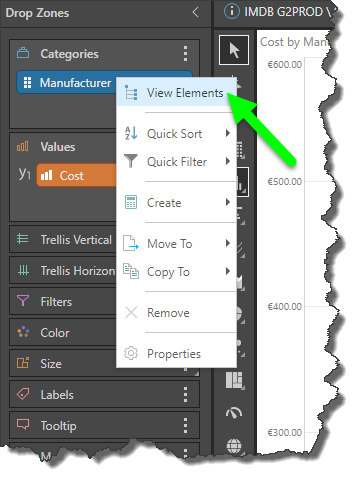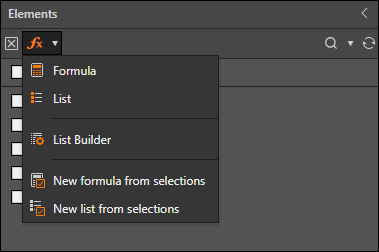Elements are the lowest level in the structure of the data model, and are contained within the member hierarchies. The Elements Tree exposes the member elements within a given member hierarchy. Users can browse the individual elements within a specified hierarchy, and then add the required elements to the query. They can also create quick formulas, lists, or parameters based on the given elements.
View Elements
To view a hierarchy's elements, you must specify the relevant hierarchy either from the dimensions panel, or from the drop zones.
From the Dimensions Panel
To browse the elements tree of a hierarchy in the Dimensions panel, right click on the hierarchy and click View Elements.

From the Drop Zones
To view the elements of a hierarchy from the drop zones, right click on the hierarchy chip and select View Elements:

Alternatively, if you've added a member hierarchy to the drop zones, you can double click on it (from the drop zone) to open its elements tree.

Elements Tree Features
Element Selection
Elements can be manually added to the query by selecting their checkbox, or removed from the query by deselecting their checkbox. You can also add or remove all elements in the hierarchy by selecting or deselecting the checkbox beside the hierarchy name.

Elements can also be added to the query in other ways, including via the list builder and members search.
Element Deselection
If the entire hierarchy was selected, you can deselect it by clicking the hierarchy label. If only some of the elements in the hierarchy were selected, you can deselect them by clicking the deselect button.
Elimination Mode
By default, Selection Mode is enabled, meaning that any selected element will be added to the query.

Switch to Elimination Mode to automatically select and strike-through all elements in the tree, and deselect the elements that should be included in the query. Click here for details on adding elements to the query from the Elements Tree.

Create Calculations
From the Create Calculations drop down, you can access tools for defining calculations.
Formula: open the Formula editor, where you can construct custom formulations in PQL or MDX.
List: open the List editor, where you can build a custom list of elements.
List Builder: open the List Builder dialog, where you can build or import a list of elements.
New formula from selections: create a new formula from the selected elements. When in Elimination mode, the formula will be based on unselected elements.
New list from selections: create a new list from the selected elements. When in Elimination mode, the list will be based on unselected elements.

Show Formulations
Toggle the Formulations icon to show or hide custom formulations. By default, formulations are displayed in a tree format; click the drop down to switch to a list view.

Search
Click the search icon to expose the search bar, where you can search for elements within the current hierarchy. If Show Formulations is enabled (see above), the search will also return custom calculations and lists matching your search string.
By default, the search will return elements and formulas whose caption begins with the given string:

To search for elements and formulas whose caption contains the given string, insert an asterisk * before the search string:

To close the search bar, click the search icon again.
Members Search
Click the search drop down to access the Members Search wizard, where you can search elements and then add them to the query and use them to build custom lists.

Refresh
Click the refresh icon to refresh metadata for custom lists, and to re-fetch the list of elements within the given hierarchy without clearing the server cache. This action does not refresh data model metadata; to refresh model metadata use the Refresh Metadata function.
